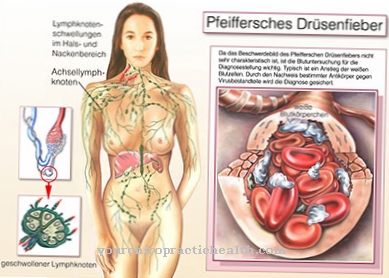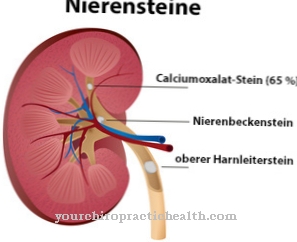The Retinitis pigmentosa is a genetically determined degeneration of the retina, in which the photoreceptors of the eyes perish bit by bit and thus usually complete blindness occurs in the late course of the disease. Often this phenomenon is only one symptom of several and together with the respective accompanying symptoms forms a whole complex of symptoms, such as Usher or Alport syndrome.
What is retinitis pigmentosa?

© Emil - stock.adobe.com
The Retinitis pigmentosa is a genetic disease of the retina that triggers retinal degeneration and also called Patermann Syndrome or Retinopathia pigmentosa is known. The Dutchman Frans Donders documented the disease as early as 1855 and coined the term retinitis pigmentosa at that time.
Since the term retinitis actually describes an inflammation and the disease as such is not related to inflammatory processes, ophthalmology later renamed the phenomenon retinopathia pigmentosa. Nonetheless, Donder's original naming is still in use today. Around three million people worldwide suffer from retinitis pigmentosa, with adolescence and middle age forming the peak of the disease.
In the case of genetically caused retinal degeneration, general eyesight gradually deteriorates over several decades. About half of all patients develop cataracts at a later stage, which is accompanied by general lens opacity. The disease also occurs in animals and is called progressive retinal atrophy in veterinary medicine.
causes
Retinitis pigmentosa is a genetic defect. More than 40 different genes can trigger the disease. In the meantime, medicine assumes a monogenetic inheritance to pass on the genetic defect, which means that several genes do not have to be defective, but the defect of just one of those identified so far can trigger the disease. The disease should be passed on in the autosomal dominant as well as in the autosomal recessive and gonosomal inheritance.
In addition to inheritance, a spontaneous mutation can also cause the pathological defect in one of the more than 40 identified genes. Under certain circumstances, toxic phenomena caused by substances such as chloroquine can be accompanied by the same symptoms as retinitis pigmentosa. In this case, however, the doctor speaks more of a pseydoretinitis or a phenocopy.
Symptoms, ailments & signs
An early symptom of retinitis pigmentosa is night blindness. Due to the gradual destruction of photoreceptors, the eyes are increasingly unable to adapt to changing light conditions and are increasingly sensitive to glare. Later, contrast vision and color vision are impaired.
Most patients also suffer from impairment of the field of vision in the form of what is known as tunnel vision. The central field of vision is usually retained for a long time. However, it can lead to total blindness in the late course. For almost a quarter of the patients, retinitis pigmentosa is not the only phenomenon, but is accompanied by many additional symptoms and thus has an effect in the form of a whole syndrome, such as Usher's syndrome.
In this context, the doctor also speaks of an associated retinopathia pigmentosa, which can be associated with hearing disorders, paralysis or cardiac arrhythmias or muscle weakness. In addition to Usher's syndrome, Alport's and Refsum's syndromes are among the most well-known complexes associated with associated retinitis pigmentosa.
Diagnosis & course of disease
The diagnosis of retinopathia pigmentosa is made using an electroretinogram. This electroretinogram enables the diagnosis to be made in early childhood. Ultimately, the earlier the diagnosis is made, the better the prospects of being able to deal with the disease later on.
The prognosis depends heavily on which of over 40 causative genes is affected by the defect, with the disease, apart from the special form of Refsum's syndrome, being considered incurable. In order to assess the exact localization of the gene effect and to be able to make a prognosis, the doctor first analyzes all additional symptoms and in the course of this, for example, gets an impression of hearing disorders and blood values. A DNA analysis can only be carried out once the exact genetic defect has been identified.
Complications
Retinitis pigmentosa is a hereditary disease of the retina, which always leads to blindness through night blindness, limited visual field and visual acuity. There is currently no therapy that promises a cure. Vitamin A may slow down the process.
Additional complications occur in those forms of retinitis pigmentosa in which other organs of the body are also affected by symptoms of the disease. This applies to around 25 percent of all those affected. Depending on the syndrome present, hearing problems, paralysis, muscle weakness, cardiac arrhythmia or mental development disorders can occur.
Within the eyes, there are sometimes other changes such as calcium deposits in the optic nerve, astigmatism, linden opacity, myopia or vascular diseases. In Usher syndrome, in addition to retinitis, there is also severe hearing impairment, which is primarily due to damage to the hair cells. Retinitis pigmentosa also occurs in the context of Laurence-Moon-Biedl-Bardet syndrome.
In addition to retinal inflammation, diabetes mellitus, high blood pressure, obesity, muscle weakness, deafness, intellectual disabilities and motor disorders occur. Cardiovascular problems can occur as a result of diabetes and high blood pressure. In other associated forms of retinitis pigmentosa, cardiac arrhythmias can also occur, which sometimes lead to life-threatening complications. Further complications arise from gait disturbances, which can often cause falls. Sometimes retinitis pigmentosa also has neurodegenerative disorders such as dementia.
When should you go to the doctor?
Retinitis pigmentosa must always be examined and treated by a doctor. This disease cannot heal itself and, in the worst case, the person affected can go completely blind. The earlier the disease is recognized and treated, the higher the likelihood of a complete cure.
A doctor should be consulted if the patient suffers from night blindness. Those affected can hardly see or recognize anything at night. Seeing different colors can also be affected by retinitis pigmentosa and should be checked by a doctor. However, those affected also suffer from hearing problems or heart problems as a result of the disease. If these symptoms occur, it is essential to consult a doctor.
Primarily, retinitis pigmentosa is treated by an ophthalmologist. The other complaints can then also be treated by a cardiologist or an ENT doctor. Whether or not a complete cure can be achieved cannot generally be predicted.
Treatment & Therapy
The progression of retinopathia pigmentosa has not yet been stopped for most forms of the disease. However, according to clinical studies, supplementation with vitamin A should be able to slow down progression in combination with hyperbaric oxygen therapy. Dealing with the disease is currently the focus of therapy.
For example, patients should be better prepared for the possible impending loss of sight through psychological care and early introduction to orientation techniques for the blind.Refsum's syndrome is an exception, because it is actually a metabolic defect whose progression can be stopped by a special diet low in phytanic acid.
For all other forms, experiments are currently being carried out with stem cell therapies and the exchange of the defective genes directly in the retina. To repair existing retinal damage, medicine is currently also working on the development of retina implants, which are intended to compensate for the loss of function of the photoreceptors. A subretinal implant with 1500 diodes should make seeing possible again in the future.
You can find your medication here
➔ Medicines for eye infectionsprevention
Retinitis pigmentosa cannot be prevented because the disease is a genetic defect.
Aftercare
In most cases, those affected with retinitis pigmentosa have only a few and only limited options or measures of follow-up care available. First and foremost, a doctor should be consulted very early so that there are no complications or other complaints in the further course. This is crucial for the further course of the disease, so that a doctor should be contacted as soon as the first signs and symptoms of the disease appear.
Retinitis pigmentosa is usually treated by taking various medications, mainly antibiotics. In doing so, regular intake with the correct dosage must always be observed, whereby antibiotics should not be taken together with alcohol. In many cases, the support and help of one's own family is also necessary in order to avoid depression or psychological upset.
In the case of children, the parents in particular must ensure that the medication is taken correctly and regularly. A general course cannot be predicted, although in some cases the life expectancy of the person affected may be reduced.
You can do that yourself
The retinal disease retinitis pigmentosa is hereditary and currently not curable. As the retinal cells die, the affected person's field of vision is restricted. Spatial vision is lost. Walking with a white cane replaces spatial orientation for him.
On the other hand, RP sufferers with tunnel vision are often still able to read with a magnifying glass. The cones in the center of the retina are responsible for this. They are functional longer than the rods that enable night and twilight vision. If these have died, the person concerned is dependent on the help of an accompanying person.
It is important that outsiders are made aware of the progressive and worsening blindness. Wearing the badge for the blind provides clarity. Aids such as Braille or voice-controlled computers make everyday life easier for those affected. The high sensitivity to glare is weakened with tinted glasses. If the contrasts become blurred and the contours in the apartment can no longer be perceived, markings that can be felt with their hands help those affected. Colored markings, on the other hand, are not suitable, since color vision is also impaired.
People affected by RP are entitled to a severely handicapped ID.
If the patient has a well-developed visual center, a chip can be implanted to help him recognize the contours of objects.
























.jpg)



